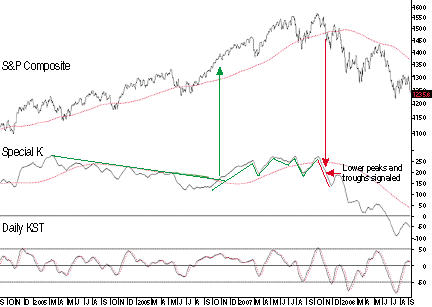INDICATORS
Major Trend Reversals And Short-Term Moves
Identifying And Timing
With The Special K
Part 2
In part 1, you were introduced to the Special K indicator and its application on the weekly and daily charts. In part 2, we will show you how Special K can be used to identify major trend reversals and for timing pro trend short-term moves.
AS I mentioned in part 1, my favorite method of displaying the Special K uses a calculation based on daily data and exclusively incorporating simple moving averages like that displayed in Figure 1. As you can see from this chart, the movements in the daily Kst and the Special K are similar. The daily Kst shows overbought and oversold conditions, which are not apparent from the summed cyclicality of the Special K. Let’s see how the Special K can be used to identify major trend reversals and to time pro trend short-term moves.
Identifying major trend reversals early
The following techniques will help better time primary trend reversals:
- Observing trendline breaks, such as that in late 2006 in Figure 1.
- Identifying a reversal in a series of rising or falling peaks and troughs. For example, the end of the bull market in November 2007 was signaled this way.
- Observing the crossovers of the Special K’s smoothing. In this case, I typically use a 100-day smoothing of a 100-day simple moving average, as shown in Figure 1. The series of declining peaks and troughs was still in force in mid-September 2008 as this article was written. Note that the 100/100 smoothing is not offered as the perfect solution but more as a smoothing that appears to work fairly consistently. In Figure 1, the green and red arrows show two such crossovers.

FIGURE 1: IDENTIFYING MAJOR TREND REVERSALS EARLY. Here in the S&P 500 Composite you see that the movements in the daily KST and Special K are similar. The daily KST shows overbought and oversold conditions, which are not apparent from the summed cyclicality of the Special K.
Using the Special K to time pro trend short-term trades
The Special K can also be used in conjunction with the daily short-term Kst. The latter can be interpreted as any other smoothed oscillator with overbought/oversold readings, moving average crossovers, divergences, and so forth.
The Special K, on the other hand, is more of a primary trend swing indicator, as it usually experiences rising peaks and troughs during a primary bull market and falling ones in a bear trend. As a result, the Special K is normally plotted with three or more years of data so that the most recent primary trend cycles are placed in perspective.